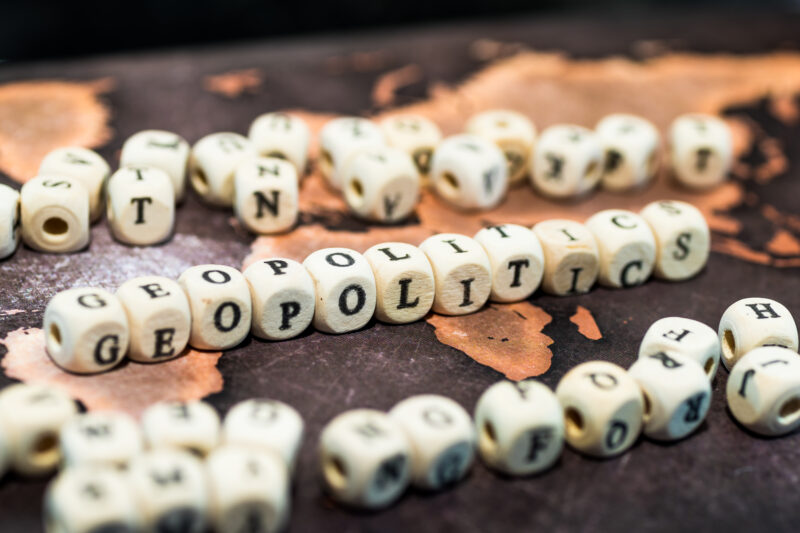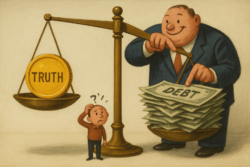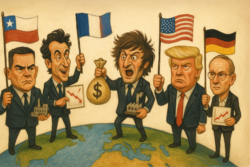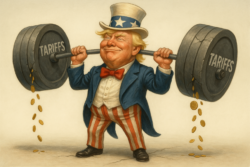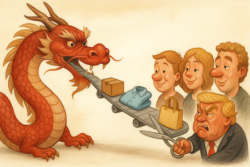While most headlines in the UK are fixated on local inflation data and the Bank of England’s next move, few are paying attention to what could be the real trigger for a financial shock on this side of the Atlantic: a deepening U.S. recession.
If you think that sounds distant, think again.
Britain’s economy is tightly interwoven with the American financial system. What happens on Wall Street doesn’t stay there—it bleeds into the FTSE, the housing market, and your portfolio.
That’s why Jim Rickards is sharing this urgent update—because he believes the U.S. is heading for a hard landing, and the shockwaves won’t stop at America’s borders. They’ll ripple through global markets, including right here in the UK.

Kris Sayce
Publisher, Southbank Investment Research
The Trump administration has hit the ground running.
Most cabinet and White House staff nominations have now been confirmed, and key positions across defence, economic policy, and national security are already filled.
Since inauguration weekend, President Trump has signed a wave of executive orders—many aimed at reversing Biden-era policies and accelerating his new economic agenda. Several more are expected in the coming weeks as the administration sharpens its focus on trade, tariffs, and national defence.
This all stands in sharp contrast to Trump’s 2016 transition process where the nominees were not well chosen, confirmation went slowly, and the deep state holdovers from the Obama administration were still in place. What a difference four years makes.
We are extremely optimistic about Trump’s economic plans. Whether by executive order, regulatory processes or legislation, Trump will be pursuing lower taxes, less regulation, and higher tariffs on foreign trading partners in order to promote high-paying jobs in the U.S.
Some complain that Trump’s America First policies may hurt growth in places like China, India and Brazil. That’s entirely possible but too bad. China needs to figure out how to Make China Great Again. That’s China’s job, not the job of the United States.Trump’s job is to Make America Great Again and he’s off to a good start.
The U.S. Consumer of Last Resort
Simply put, the U.S. consumes more than it produces. Americans buy consumer goods and solar panels from China, semiconductors from Taiwan, steel from Japan and automobiles from Korea. The difference is purchased from abroad and paid for with U.S. dollars, which foreign central banks use to load up on U.S. debt.
The U.S. runs a trade deficit along with a budget deficit and is in debt to the world. Those days are over. Asians, Africans and Latin Americans can still sell goods to the U.S. but they’ll have to manufacture those goods in the U.S. to get over high tariff walls. The result is good paying jobs in America.
With higher earnings, Americans can save more. Foreign investment in the U.S. will also rise as foreign manufacturers build here to avoid tariffs. Eventually, higher savings and higher investment will close the production gap and reduce the trade deficit. Among other consequences, look for a stronger dollar as the world scrambles for dollars to invest here. That makes the rest of the world cheaper for U.S. consumers and reduces inflation also. It’s a win-win-win policy.
3 Threats on the Horizon
The fact that Trump’s policies are sound, and the long-term economic prospects are good, should not divert us from the fact that there are serious economic challenges in the near-term. These will not be Trump’s fault because they have been years in the making. But the damage may emerge early in Trump’s term.
This scenario is not unlike the start of Ronald Reagan’s first term in 1981. The U.S. had its worst recession since the end of World War II during 1981-82. (We’ve had worse recessions since, but 1981-82 was the worst up until that time).
It took a few years for Reagan’s policies to take effect. The period 1983-1986 was one of the strongest growth spurts in recent history with 16% compounded real growth. But we had to get through a rough patch first.
Here’s a summary of three economic threats to investors that may emerge over 2025 before we get to higher ground expected in 2026 and beyond:
1. Stock Market Crash
Markets are at or near all-time highs based on every available metric: P/E ratios, the CAPE ratio, market cap/GDP ratio, concentration risk, etc. This stock market bubble is amplified by indexing, investor complacency and analyst euphoria. When such conditions have existed in the past, they have always been followed by market crashes of 50% to 90% unfolding over several years. Examples include the Dow Jones Industrial Average (1929), the Nikkei (1989), NASDAQ (2000), and the S&P 500 Index (2008).
We are now positioned for an historic crash. The specific cause does not matter – it could be war, natural disaster, a bank or hedge fund collapse or other unexpected event. What matters is the super-fragility of the market when the trigger is pulled. This is why Warren Buffett has over $300 billion in cash and why central banks are buying gold.
Investors should prepare now; don’t be the last one to know. Strategies include reducing allocations to stocks, increasing allocations to cash and purchasing some gold (up to 10% of your investable assets) to participate in a flight to quality.
2. A U.S. Recession Is Coming
This is problematic for stocks independent of any crash potential. Inflation has persisted, energy prices are back up to interim highs, unemployment is going up, job hiring is frozen, and the manufacturing sector is contracting.
Federal reserve rate cuts won’t help. They do not provide “stimulus.” Rate cuts are a sign of economic weakness, not strength. The Fed is not leading the interest rate market. They are following the market down.
Of course, a recession could trigger a market crash. But even if it does not, recessions are typically associated with 30% declines in stock valuations over a year or less. The investment strategy for a recession is substantially the same as the crash strategy.
3. Currency Wars Are Back and Trade Wars Are Coming
The super-strong dollar today makes it difficult for other countries to buy U.S. goods. Tariffs will make the global dollar shortage worse as foreign investors seek dollars to jump the tariff walls and invest directly in the U.S.
Both the strong dollar and the coming U.S. tariffs invite retaliation by trading partners who will put up their own tariff walls. The result will be a global contraction in trade that could resemble the trade collapse of the 1930s during the Great Depression. U.S. stocks fell 85% from October 1929 to June 1932 during that episode of trade wars. A repeat could be on the way if economies such as China (that should be boosting consumption) choose to fight trade wars instead.
We’ll be closely monitoring all these threats and provide you with the best in analysis and recommendations in the coming weeks and months.
Best,

Jim Rickards
Contributing Editor, Investor’s Daily
I’ve said it before, and I’ll say it again: the U.S. is heading for a recession—and when it hits, it won’t stop at America’s borders.
Markets in the UK and across Europe are tightly connected to the U.S. economy. That’s why I’ve been urging investors to look beyond the headlines… and pay attention to a much bigger shift already underway.
In my latest briefing, The American Birthright, I reveal how a long-dormant legal mechanism—just reactivated by the Trump administration—could unlock an estimated $150 trillion in hidden American wealth.
And yes, British investors can legally claim a stake.
This may be the most important financial move of the next decade.
Mission Accomplished
Bill Bonner, from Buenos Aires, Argentina
What a glorious, gaudy, giddy war! While it lasted…
We refer to the ‘Great Trade War’ started with horns blowing and flags waving by Donald J. Trump. All the thrill of battle with no dead bodies. All the righteous excitement of a Worthy National Cause, good vs. evil…right vs. wrong…and all we stood to lose was money.
It was billed as the trade war to end trade wars…with a Liberation Day that was to usher in a new Golden Era for the US. From now on, the playing field would be level… and we Americans would be winners again.
We imagined the great victories — over China, Europe, Vietnam, who had been ‘ripping us off’ for decades.
And then there would be a victory parade, perhaps down Broadway in Gary, Indiana…
POTUS could announce ‘mission accomplished’ on the deck of a cargo ship, idled off of Long Beach, and then hand out Trade War Service medals to Pete Navarro and Scott Bessent. (The military humor site, Duffel Blog, reports that the medals may be delayed because of Chinese retaliatory tariffs!)
Like all the best wars, America’s Trade War was intended to be short, sweet, and victorious. “Trade wars are easy to win,” said America’s leader. It was supposed to be only a few weeks before the enemy surrendered and the fentanyl, illegal immigrants, and cheap (unfair!) products stopped flooding over the border…with new factories popping up all over America.
But the trade war went bad, almost from the first day. The war aims were never clear. Drugs? Immigration? Manufacturing revival? Revenue raising? Were we trying to right wrongs… or get rich?
What exactly were we trying to do?
At first, tariffs seemed like a goal in themselves. They would be ‘reciprocal’ — erasing many years of unfair, unbalanced trade.
But hardly had the ships appeared on the horizon when the Liberation Day landings were aborted. A pause was announced, giving the enemy a chance to ‘negotiate.’ Maybe they could just buy more tanks and airplanes from US industries? And maybe we’d call off the war? They were lining up to kiss Donald Trump’s derriere, we were told; was that the goal? They had to do a deal, POTUS explained, in order to get access to US consumers.
But they already had access…and we already had deals in place with all of them. Was the idea to reduce the current trade-weighted tariff average of 2.2%…to 2.1%? “No,” said trade advisor Pete Navarro. Even if the tariffs went to zero, that wouldn’t stop the trade war.
As near as we can tell the real goal was simply to bring trade under political control… with the ‘deals’ controlled by Donald Trump himself.
Apple, Nvidia, and other companies got the message. They lined up.
Now it was Americans who were kissing the president’s duff. CNN:
It started with iPhones, which under Trump’s 145% China tariffs were set to more than double in price. But Apple CEO Tim Cook called the White House and soon secured a reprieve, the New York Times reports.
Other businesses took note, and soon CEOs and lobbyists were scrambling to make their case for why their burning house also deserves some water.
On Monday, the CEOs of Walmart, Target, Lowe’s and Home Depot descended on the White House to discuss tariffs… scrambling to get the president’s attention.
“There’s only one person that can really authorize that exemption and that’s the president,” a business representative with close ties to the Trump administration told Politico. “So if you’re not a company that can whisper in the president’s ear or make the trip to Mar-a-Lago and do it persuasively, then you’re sort of frozen out of the process for now.”
In his press conference on Tuesday, the president said he wasn’t going to play hardball with the Chinese. Instead, he was going to be ‘nice.’
Why?
Because, while all of this puckering up was going on a disturbing new insight had reached the White House. Trade wars lead to falling stock prices. And prices only go back up when investors believe the trade war has been called off.
Trump insisted that he was ‘bringing China et al. to the bargaining table.’ But now it was actually Trump himself who needed a deal.
The deal-maker had maneuvered himself into a losing position. The only way he can keep the stock market from collapsing is by abandoning his own trade war. The Wall Street Journal:
“Another harsh reality is that China called Mr. Trump’s bluff and seems to have won this round.”
In short, the war is over. Now Team Trump is making deals. Like the deal they negotiated with Canada and Mexico during his last term, trade will go on much as it did before. And — despite his blustery blah blah — it is Trump himself who will bend over and pucker up.
Regards,

Bill Bonner
Contributing Editor, Investor’s Daily
For more from Bill Bonner, visit www.bonnerprivateresearch.com
